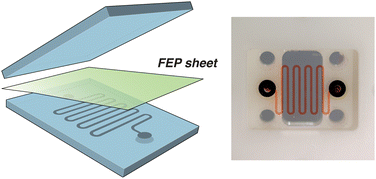In this work a novel room-temperature bonding technique based on chemically activated Fluorinated Ethylene Propylene (FEP) sheet as an intermediate between chemically activated substrates is presented. Surfaces of silicon and glass substrates are chemically modified with APTES bearing amine terminal groups, while FEP sheet surfaces are treated to form carboxyl groups and subsequently activated by means of EDC–NHS chemistry. The activation procedures of silicon, glass and FEP sheet are characterized by contact angle measurements and XPS. Robust bonds are created at room-temperature by simply pressing two amine-terminated substrates together with activated FEP sheet in between. Average tensile strengths of 5.9 MPa and 5.2 MPa are achieved for silicon–silicon and glass–glass bonds, respectively, and the average fluidic pressure that can be operated is 10.2 bar. Moreover, it is demonstrated that FEP-bonded microfluidic chips can handle mild organic solvents at elevated pressures without leakage problems. This versatile room-temperature intermediate layer bonding technique has a high potential for bonding, packaging, and assembly of various (bio-) chemical microfluidic systems and MEMS devices.

You have access to this article
 Please wait while we load your content...
Something went wrong. Try again?
Please wait while we load your content...
Something went wrong. Try again?


 Please wait while we load your content...
Please wait while we load your content...